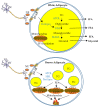Neuroendocrine Regulation of Energy Metabolism Involving Different Types of Adipose Tissues
- PMID: 31159462
- PMCID: PMC6600468
- DOI: 10.3390/ijms20112707
Neuroendocrine Regulation of Energy Metabolism Involving Different Types of Adipose Tissues
Abstract
Despite tremendous research efforts to identify regulatory factors that control energy metabolism, the prevalence of obesity has been continuously rising, with nearly 40% of US adults being obese. Interactions between secretory factors from adipose tissues and the nervous system innervating adipose tissues play key roles in maintaining energy metabolism and promoting survival in response to metabolic challenges. It is currently accepted that there are three types of adipose tissues, white (WAT), brown (BAT), and beige (BeAT), all of which play essential roles in maintaining energy homeostasis. WAT mainly stores energy under positive energy balance, while it releases fuels under negative energy balance. Thermogenic BAT and BeAT dissipate energy as heat under cold exposure to maintain body temperature. Adipose tissues require neural and endocrine communication with the brain. A number of WAT adipokines and BAT batokines interact with the neural circuits extending from the brain to cooperatively regulate whole-body lipid metabolism and energy homeostasis. We review neuroanatomical, histological, genetic, and pharmacological studies in neuroendocrine regulation of adipose function, including lipid storage and mobilization of WAT, non-shivering thermogenesis of BAT, and browning of BeAT. Recent whole-tissue imaging and transcriptome analysis of differential gene expression in WAT and BAT yield promising findings to better understand the interaction between secretory factors and neural circuits, which represents a novel opportunity to tackle obesity.
Keywords: RNA sequencing; adipokines; batokines; beige adipose tissue; brown adipose tissue; denervation; fatty acid oxidation; high-fat diet; innervation; lipolysis; sympathetic nervous system; thermogenesis; white adipose tissue.
Conflict of interest statement
The authors declare no conflict of interest. The founding sponsors had no role in the design of the study; in the collection, analyses, or interpretation of data; in the writing of the manuscript, and in the decision to publish the results.
Figures



Similar articles
-
Overexpression of Adiponectin Receptor 1 Inhibits Brown and Beige Adipose Tissue Activity in Mice.Int J Mol Sci. 2021 Jan 18;22(2):906. doi: 10.3390/ijms22020906. Int J Mol Sci. 2021. PMID: 33477525 Free PMC article.
-
An update on the secretory functions of brown, white, and beige adipose tissue: Towards therapeutic applications.Rev Endocr Metab Disord. 2024 Apr;25(2):279-308. doi: 10.1007/s11154-023-09850-0. Epub 2023 Dec 5. Rev Endocr Metab Disord. 2024. PMID: 38051471 Free PMC article. Review.
-
Plasticity of Adipose Tissues: Interconversion among White, Brown, and Beige Fat and Its Role in Energy Homeostasis.Biomolecules. 2024 Apr 16;14(4):483. doi: 10.3390/biom14040483. Biomolecules. 2024. PMID: 38672499 Free PMC article. Review.
-
Traveling from the hypothalamus to the adipose tissue: The thermogenic pathway.Redox Biol. 2017 Aug;12:854-863. doi: 10.1016/j.redox.2017.04.019. Epub 2017 Apr 15. Redox Biol. 2017. PMID: 28448947 Free PMC article. Review.
-
Thermogenesis in Adipose Tissue Activated by Thyroid Hormone.Int J Mol Sci. 2020 Apr 24;21(8):3020. doi: 10.3390/ijms21083020. Int J Mol Sci. 2020. PMID: 32344721 Free PMC article. Review.
Cited by
-
Dietary Options for Rodents in the Study of Obesity.Nutrients. 2020 Oct 22;12(11):3234. doi: 10.3390/nu12113234. Nutrients. 2020. PMID: 33105762 Free PMC article. Review.
-
Effect of Lauric vs. Oleic Acid-Enriched Diets on Leptin Autoparacrine Signalling in Male Mice.Biomedicines. 2022 Aug 2;10(8):1864. doi: 10.3390/biomedicines10081864. Biomedicines. 2022. PMID: 36009410 Free PMC article.
-
Screening and validation of differentially expressed genes in adipose tissue of patients with obesity and type 2 diabetes mellitus.Biomol Biomed. 2024 Jan 3;24(1):40-50. doi: 10.17305/bb.2023.9498. Biomol Biomed. 2024. PMID: 37597213 Free PMC article.
-
Hypothalamic Neuromodulation of Hypothermia in Domestic Animals.Animals (Basel). 2024 Feb 4;14(3):513. doi: 10.3390/ani14030513. Animals (Basel). 2024. PMID: 38338158 Free PMC article. Review.
-
Generation of Functional and Mature Sympathetic Neurons from Human Pluripotent Stem Cells via a Neuroepithelial Route.J Mol Neurosci. 2024 Feb 15;74(1):19. doi: 10.1007/s12031-024-02196-5. J Mol Neurosci. 2024. PMID: 38358571
References
Publication types
MeSH terms
Substances
Grants and funding
LinkOut - more resources
Full Text Sources

